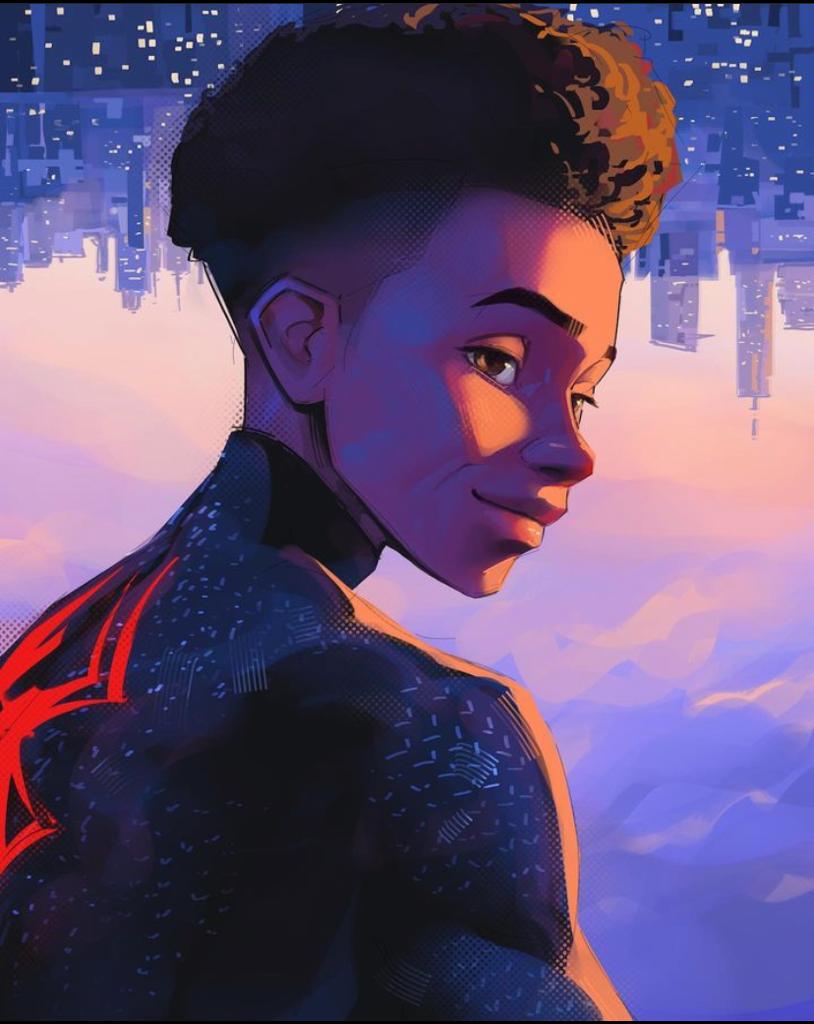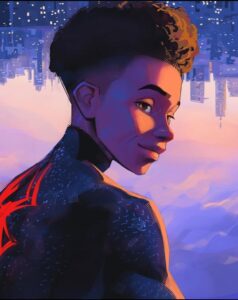
Directed by – Joaquim Dos Santos, Kemp Powers and Justin K. Thompson
Screenplay – David Callaham, Philip Lord and Christopher Miller
Rating – 4.5/5 stars
Ebert Scale – 2 Thumbs Up
First Impressions
Outrageously ambitious in scope, theme and visual wizardry, Across The Spider-Verse, carries on the cinematic tradition of its predecessor. With jaw-droppingly gorgeous animation and a cohesive story, ATSV puts the last decade or so’s an animated pantheon to shame.
With its predecessor’s impeccable hip-hop-inspired soundtrack (think Sunflower and What’s Up Danger) and a tightly written script rounding off an almost perfect movie, it was clear that Sony would capitalize on ITSV’s success. It’s been nearly 5 years since then, but the sequel justifies every second of its prolonged production. Lord and Miller outdo themselves in this 2 hr 16-minute behemoth of a film. While not every beat lands as consistently as the original, the highs are higher than ever.
If it sticks the landing, this series looks set to be the greatest superhero movie trilogy of all time. But that’s not even the category the creators believe it belongs in. The project has been transformative to the animation industry, and only time will reveal its full impact. Unapologetically beautiful and impossibly vivacious in its visual style, Across The Spider-Verse is a lock for the animation Oscar.
Spoiler Territory
ATSV begins right where the first movie leaves us, but this time from the perspective of Gwen Stacy (voiced by Hailee Steinfeld). It’s telling that the film begins and ends with her characteristic drum-roll theme mashing into that of Miles (Shameik Moore), putting the movie’s two protagonists front and centre.
The first half sets up Gwen’s estrangement from her father and Miles’ growing disillusionment with his family and his responsibilities as a vigilante. The big reveal that Miles is the original multiversal anomaly is hinted at throughout the first hour of the movie, in the hidden glares of Miguel O’Hara (Oscar Isaac) and Spider-Woman (Issa Rae), as well as clever easter eggs throughout the first movie.
The movie begins brilliantly, but the nervous tension of its opening act is tempered by a relatively slower ending to the first half. But it does its job, immersing us in Miles’ and Gwen’s worlds in a way that mindless action sequences would not. And when the character moments begin to pay off in the second hour, it all makes sense.
Oscar Isaac absolutely crushes it as O’Hara, with a genuine menace and a tinge of insecurity that fit so well with the overall design of Spider-Man 2099. As the smooth tones of his techno-based theme collide with the violent integrity of his actions, you know he’s here to stay.
Karan Soni (Pavitr Prabhakar) and Issa Rae (Spider-Woman) do their best with the limited screen time they get in this juggling act of a movie that must balance almost 200 unique Spider characters. But the real star of the show is Daniel Kaluuya’s Spider-Punk (Hobie Brown). With unmatched visual freneticism, and the effortless cool to back up his anarchist credentials, he’s the secret ingredient that makes this movie work as well as it does. ITSV has Uncle Aaron as the Prowler, while ATSV has Hobie Brown, innit.
Jake Johnson returns as Peter B. Parker, happier than ever with a baby daughter. The characters from the first movie return primarily as cameos, as scriptwriter David Callaham focuses instead on their relatively unknown main antagonist, the Spot. While his character doesn’t work perfectly, the Spot takes a sharp turn in the second half, showcasing a genuinely terrifying villain by the end of it.
Superficially, the Spot is a perplexing choice for a big bad. He lacks physical and mental charisma, and the unclear nature of his dimension-hopping powers only adds to his unanchored place in the Multiverse. But Lord and Miller make it work – with a visual transformation that’s both visceral and unnerving. By the end of the movie, he’s juxtaposed himself perfectly as the central wrench in the works, and his motivations carry real menace.
And what do you even say about the ending? While most moviegoers will be aware that ATSV is the first in a two-part finale (with Beyond The Spider-Verse scheduled for a 2024 release), the ending is still unexpected in all the right ways. The switcheroo in the final ten minutes is picture-perfect, with just enough clues for eagle-eyed viewers to notice what’s wrong and the brilliant framing that Lord and Miller have accustomed us to.
That’s when Pemberton’s ‘Start A Band’ plays out to the bait-and-switch unveiled in the last ten minutes. Accompanied by the ghosts of his past, as Miles swings through a shadowy, drenched Brooklyn, Gwen Stacy realizes that the Multiverse is malleable. However, she can do little when Miles is universes away, facing a fatherless version of himself.
Nitpicks
For all the gushing praise we’re giving this slam dunk of a movie, not everything in it works. The film hits its beats so well that the dominoes it must set up in the first half can largely be ignored. But the runtime (at 2 hrs and 16 minutes) does start to weigh on you, especially on repeat viewings.
Another problem symptomatic of comic book movies, in general, is the sometimes inconsistent tone. The film falls into the MCU trap of underwriting emotional scenes with unnecessary jokes. These only undermine the tension and prevent emotional stakes from forming in the first place. Don’t get me wrong; this movie is a minor offence in this category. By and large, the comedy works well (when it’s not undercutting an emotional scene). Still, there are jarring breaks in the overall tone that serve only as audience applause moments. They do sting, if only for the fact that the movie would be near perfect without them.
Celebrity and comic book cameos abound through Across The Spider-Verse, from a live-action Prowler played by Donald Glover to Andrew Garfield’s Spider-Man appearing in a flashback. The Spectacular Spider-Man and the animated jeep Peter Parkedcar (probably the best gag in the movie) also appear. With more obscure characters than you can count, this movie has easter eggs sewn into every frame.
On the flip side, whenever a live-action cameo occurs, it looks dull, bland and uninteresting compared to the vibrant universe the animators have created. It’s a testament to our times, where blockbusters can no longer awe us and must instead confound us with CGI firestorms.
This brings me to my next nitpick: how certain characters were handled. Ben Reilly’s Scarlet Spider is relegated to a mopish joke, and the humour they want to elicit from him falls flat. An otherwise charismatic and dangerous character is relegated to a C-list henchman.
Issa Rae’s Spider-Woman is unnecessarily villainous in ways that do not match her comic roots, and her one-note performance throws away what would have otherwise been a great character.
Racking Up The Score
Given the critically acclaimed soundtrack of the first film, ATSV had great expectations to meet. Budding star Daniel Pemberton returns to score the movie, with Leland ‘Metro Boomin’ Wayne producing the official album. They’re perhaps the only artists you’d trust to outdo the original. While the soundtrack does a great job of recapturing the universe, the album comes up short compared to its predecessor.
While Pemberton returns in spectacular fashion, Leland fails to match the first film, even with the stellar voice cast he’s brought along for the ride.
Pemberton mixes and matches tunes from the first film while exploring more and more of the aural landscape of these movies. The result is an instantly recognizable score that matches and furthers the chaotic energy of the first film.
It’s not all bad, though (or remotely close, for that matter); tracks like ‘Am I Dreaming’ (inexcusably relegated to the end credits), ‘Calling’ and ‘Home’ stand out among the otherwise mediocre album. Once again, a hip-hop artist falls to the movie soundtrack album curse.
Every Frame A Painting
When Christopher Miller declared that the visuals in ATSV would make the first movie look ‘absolutely quaint’, one had to respect the gall it took to make a statement of that calibre. But it’s true; this is a movie where every frame could be a painting.
The distinctive art style that inhabits each of the six worlds we visit looks like it could have been made into a movie of its own. From the pastel brush strokes of Pavitr Prabhakar’s Manhattan to the lucid water-colour dreamland of Gwen Stacy’s Chelsea to Miles’ own version of Brooklyn, it becomes clear that these are not just visual choices. They form so much of their respective characters that they’re almost inseparable. As Miles swings through the crowded immigrant neighbourhoods of his borough, the invisible crowds weighing on him mirror the claustrophobia that pervades his personal life.
Gwen’s watered-down version of New York is also emblematic of her character. She feels adrift in a friendless, motherless world, and the only flashes of bright colour are few and far between. The hazy silhouettes of Chelsea’s skyline feel just as empty (though startlingly beautiful) to us as they do to her. As she searches for somebody to share her identity and joys with, the hollow hues of her universe seem to seep into her home and identity – as a wraith from her past.
Spider-Punk’s dazzlingly erratic visual style has a charisma of its own. With a shape-shifting guitar on his back and a suit that’s more functional than aesthetic, every time he’s on screen is a real treat. He’s been this cool the whole time, and as he swerves his way through the Multiverse, the movie is much better off with him in it.
Final Thoughts
ATSV is a movie best served by multiple viewings. It’s a movie jam-packed with easter eggs and character moments, making the storyline more cohesive on repeat viewings. (Watch Spider-Punk steal a watch for Gwen, and his tirade against Miguel suddenly makes much more sense).
With a plot and character themes far more ambitious than the first movie and mind-blowing visuals, ATSV more than compensates for any perceived flaws. Any nitpicking comes from the sky-high expectations set by the first movie and the 5-year wait to see this one.
Where does ATSV fit into the cultural lexicon? It’s important to consider any piece of media objectively. The plot and performances are excellent – but they’re hardly groundbreaking. They’re telling the stories of characters we know and love. The true legacy of this series will be its graphic design. In a time where we’re progressively weaned off the big screen and onto smaller and smaller ones – ATSV reminds us of why the big screens exist in the first place. Rampant with an infectious enthusiasm packed into every frame, it’s a cinematic triumph in the age of mediocrity.
Written by Arjun Khade for MTTN
Edited by Navya Behrani for MTTN
Featured images and artwork by Sam Young


Leave a Reply
You must be logged in to post a comment.